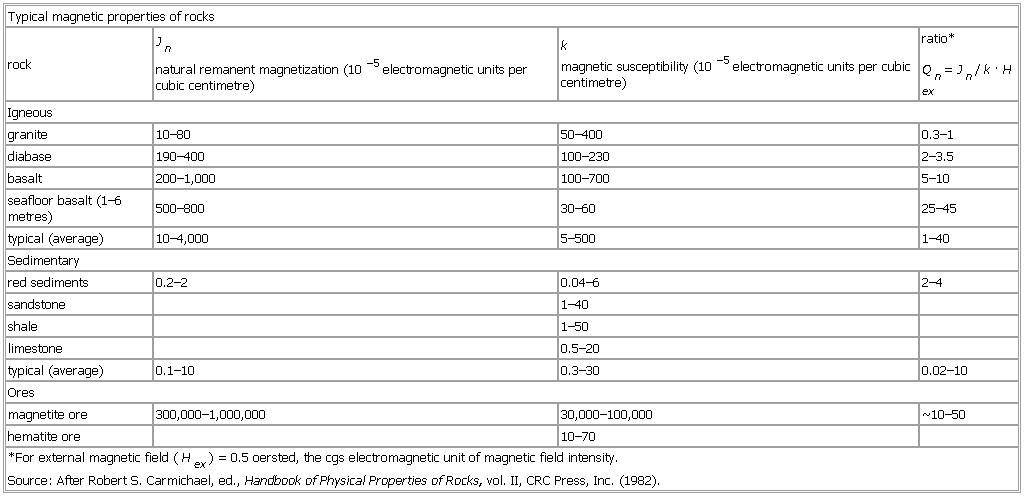Typical magnetic properties of rocks
- Typical magnetic properties of rocks
-
Typical magnetic properties of rocks
rock Jn
natural remanent magnetization (10−5 electromagnetic units per cubic centimetre) k
magnetic susceptibility (10−5 electromagnetic units per cubic centimetre) ratio*
Qn=Jn/k·Hex
Igneous
granite 10–80 50–400 0.3–1
diabase 190–400 100–230 2–3.5
basalt 200–1,000 100–700 5–10
seafloor basalt (1–6 metres) 500–800 30–60 25–45
typical (
average) 10–4,000 5–500 1–40
Sedimentary
red sediments 0.2–2 0.04–6 2–4
sandstone 1–40
shale 1–50
limestone 0.5–20
typical (
average) 0.1–10 0.3–30 0.02–10
Ores
magnetite ore 300,000–1,000,000 30,000–100,000 Typical magnetic properties of rocks10–50
hematite ore 10–70
*For external magnetic field (Hex) = 0.5 oersted, the cgs electromagnetic unit of magnetic field intensity.
Source: After Robert S. Carmichael, ed., Handbook of Physical Properties of Rocks, vol. II, CRC Press, Inc. (1982).
See as table:
* * *
Universalium.
2010.
Look at other dictionaries:
Earth's magnetic field — Computer simulation of the Earth s field in a normal period between reversals.[1] The tubes represent magnetic field lines, blue when the field points towards the center and yellow when away. The rotation axis of the Earth is centered and… … Wikipedia
rock — rock1 rockless, adj. rocklike, adj. /rok/, n. 1. a large mass of stone forming a hill, cliff, promontory, or the like. 2. Geol. a. mineral matter of variable composition, consolidated or unconsolidated, assembled in masses or considerable… … Universalium
Rock — /rok/, n. a male given name. * * * I In geology, a naturally occurring and coherent aggregate of minerals. The three major classes of rock igneous, sedimentary, and metamorphic are based on the processes that formed them. These three classes are… … Universalium
geomagnetic field — Magnetic field associated with the Earth. It is essentially dipolar (i.e., it has two poles, the northern and southern magnetic poles) on the Earth s surface. Away from the surface, the field becomes distorted. Most geomagnetists explain the… … Universalium
Earth Sciences — ▪ 2009 Introduction Geology and Geochemistry The theme of the 33rd International Geological Congress, which was held in Norway in August 2008, was “Earth System Science: Foundation for Sustainable Development.” It was attended by nearly… … Universalium
Geology of Mars — Mars Mars as seen by the Hubble Space Telescope Designations … Wikipedia
chemical compound — Introduction any substance composed of identical molecules consisting of atoms (atom) of two or more chemical elements (chemical element). All the matter in the universe is composed of the atoms of more than 100 different chemical elements … Universalium
Plate tectonics — The tectonic plates of the world were mapped in the second half of the 20th century … Wikipedia
rare-earth element — /rair errth /, Chem. any of a group of closely related metallic elements, comprising the lanthanides, scandium, and yttrium, that are chemically similar by virtue of having the same number of valence electrons. Also called rare earth metal. [1955 … Universalium
spectroscopy — spectroscopist /spek tros keuh pist/, n. /spek tros keuh pee, spek treuh skoh pee/, n. the science that deals with the use of the spectroscope and with spectrum analysis. [1865 70; SPECTRO + SCOPY] * * * Branch of analysis devoted to identifying… … Universalium

